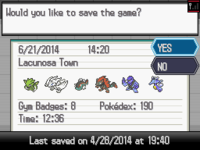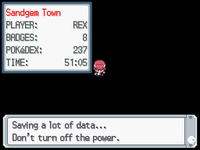Save

Saving (Japanese: レポート Report) is a function used in Pokémon games which allows the player to start from where they saved the next time they turn on their game. Saving is required when using certain features of the game such as going to the Global Terminal and entering a Battle Tower. After defeating the Elite Four, the game automatically saves. If there is already a saved game file, the player must first overwrite the existing save file with the new data. A new game can be started if there is a saved game file; however, the new file cannot be saved unless it overwrites the existing file. From Generation IV onward, any existing data must be manually deleted from the title screen by pressing ↑ + B + Select before a new game can be saved. Saving also plays a role in several glitches and in obtaining glitch Pokémon.
In the event that the saving process is interrupted, the save data risks corruption, effectively removing the player's chance of resuming from where they left off, thus forcing the player to start the game from the beginning again. The game will prompt the player when this happens the next time they access the game menu. On the GBA and DS games, there is a back-up save, meaning if the saving process is interrupted, and the save file is corrupted, then the previous save file will be loaded. Interrupting saving in GBC games may result in data loss or the save file becoming completely corrupted.
The process of saving
Generation I
Generation I Pokémon games save with a one-step confirmation—"Would you like to save the game?". If the game being saved is different from the game currently saved, an additional confirmation message displays—"The older file will be erased to save. Okay?". Choosing "Yes" overwrites the previous save data in both cases. During the save, the message "Now saving..." and, upon completion, "<player> saved the game!".
Generation II
In Generation II, saving the game is always a two-step process except for the player's very first save. The same prompt from Generation I first displays—"Would you like to save the game?"—followed by a secondary prompt, "There is already a save file. Is it OK to overwrite?". An additional message displays while the game is saving, advising the player not to turn off the power. If the game being saved is different from the game currently saved, the secondary confirmation reads "There is another save file. Is it OK to overwrite?". This is very similar in wording to the usual second prompt.
Generation III
Generation III attempted to better secure the saving process with the addition of a backup save file, which is loaded if the primary save file becomes corrupted. The regular saving prompts are the same as in Generation II; however, if the game being saved is different from the game currently saved, a more detailed warning appears—"There is a different save file that is already saved. Is it okay to overwrite it?". Pokémon FireRed, LeafGreen, and Emerald display a more severe warning message:
"WARNING!
There is a different game file that is already saved.
If you save now, the other file's data, including items and POKéMON, will be entirely lost.
Are you sure you want to save now and overwrite the other save file?"
In Pokémon Colosseum and Pokémon XD: Gale of Darkness
Pokémon Colosseum requires the player to use the PC for saving, as opposed to the handheld main series games, which allow the player to save anywhere. The "save anywhere" feature was restored in Pokémon XD: Gale of Darkness.
Generation IV

In Generation IV, the two-step save process and prompts from Generation III remain, as does the backup save file feature. In Pokémon Diamond and Pearl and Platinum, the usual "Saving..." prompt will read "Saving a lot of data..." if the player has used the Pokémon Storage System at all during their session; this includes capturing a Pokémon and sending it automatically to a PC box as well as using a PC directly. When "Saving a lot of data", the process will take significantly longer.
In this generation, the player is prevented from saving the game if it is different from the game currently saved. If the player selects "New Game" from the title screen while save data remains, the player is cautioned: "WARNING! There is already a saved game file. If you start an adventure now, you will not be able to save it." If the player starts a new game anyway, and tries to save, they will be told "There is already a saved game file. It is impossible to save. Please refer to the Instruction Booklet for details." The instructions for how to delete a saved game—"Press Up + SELECT + B Button on the title screen if you want to erase the current saved game file." follow after both messages in Pokémon Diamond and Pearl, but not in Pokémon HeartGold and SoulSilver.
If the player decides to delete the previous data by pressing Up, Select and B on the title screen, they will first be asked to confirm the deletion, and are warned of the consequences: "Once data has been deleted, there is no way to recover it." Pokémon HeartGold and SoulSilver display an additional message: "Furthermore, Pokéwalker registered data will also be erased." They are then asked to confirm the deletion once more before the save file is finally deleted.
Generation V
In Generation V, the saving process is similar to that of Generation IV, but with two differences. First, the "There is already a save file. Is it OK to overwrite?" prompt that was utilized since Generation II was removed, making the save process only one step instead of two. Second, while saving, there is now a progress bar at the bottom of the screen to indicate the current progress of data saving. The long save times of Generation IV have been rectified by giving the player only 8 boxes in the Pokémon Storage System until each one of the 8 has at least one Pokémon in it, avoiding the need to encrypt empty box data.
Corrupted save file
A save file can become corrupted due to interrupting saving (only in Generations I and II), cheating, or abusing certain glitches, such as the ZZAZZ glitch. Physical damage to the game cartridge, such as from dropping it, may result in corruption in the first three Generations. Improperly set cartridges (and memory cards in the case of games for the Nintendo GameCube) may cause data to be read as corrupt, in such instances turning the system off and reinserting the cartridge properly will cause the data to be read correctly.
List of activities
This is a list of activities which require saving before they can be used.
Generation I
- When using the Pokémon Storage System to move Pokémon into other boxes
- When entering the Cable Club
- Entering the Hall of Fame (automatic)
Generation II
- When using the Pokémon Storage System to move Pokémon into other boxes
- When entering the Cable Club
- When challenging the Battle Tower
- Entering the Hall of Fame or defeating Red (automatic)
Generation III
- Entering a Battle Tower or, in Pokémon Emerald, another location in the Battle Frontier to participate in battles
- When entering the Cable Club or Wireless Club
- Trading a Pokémon
- Entering the Hall of Fame (automatic)
Generation IV
- Entering a Battle Tower or, in Pokémon Platinum as well as HeartGold and SoulSilver, another location in the Battle Frontier to participate in battles
- Using Nintendo Wi-Fi Connection
- Entering the Global Trade Station
- Trading a Pokémon
- Using the Explorer Kit
- Entering the Colosseum or the Union Room
- Entering the Hall of Fame or defeating Red (automatic)
- Entering the Trainer House
Generation V
- Entering the Battle Subway
- Using Nintendo Wi-Fi Connection
- Using the Global Terminal
- Using Game Sync
- Trading a Pokémon
- Entering the Colosseum or the Union Room
- Changing the DS's Wi-Fi settings through the C-Gear
- Using Poké Transfer
- Entering the Hall of Fame (automatic)
In side games
In the Pokémon Ranger series
In the games Pokémon Ranger, Pokémon Ranger: Shadows of Almia and Pokémon Ranger: Guardian Signs, the game may be saved with terminals known as save machines. Save machines are typically located in Ranger Bases and Ranger Depots, although there are many located in areas all over the Fiore, Almia and Oblivia regions, both indoors and outdoors.
When no save machine is available, players may use a "quick save" feature, which temporarily saves their progress if they are unable to reach a save machine. However, quick save data is deleted when loaded, whereas progress saved via save machine will remain in the file permanently.
In the many Ranger Net missions, if the player attempts to use a save machine, it will be out of service.
In the Pokémon Mystery Dungeon series
Saving typically happens in the player's bed or at Kangaskhan Rocks. However, if the player wishes to save (and immediately return to the main menu), they may use a "quick save" option found in the in-dungeon menu's Options section, and then selecting "Quicksave or Give Up".
In Pokémon Mystery Dungeon: Explorers of Time, Darkness and Sky, the menu is expanded, and the button is relocated to a new section known as the "Rest" section.
In Pokémon Conquest
To delete a save file in Pokémon Conquest, press and hold A, B, X, and Y simultaneously on the company logo screen (before the title screen).
Trivia
- In Generations I, II, and Pokémon Emerald, there are cloning glitches which exploit the use of saving.
- The question for double-checking a save, i.e., the information given to the player that saving will cause the previous save to be overwritten (considering that there is already a save file created), was officialized internationally in Generation II. However, the question was present in Pokémon Red and Green as a one-time reconfirmation and it was implemented in a very unusual manner, since it was only made when the player tried to perform their first save. This was changed in Pokémon Blue, where the save process will only involve a confirmation request and a message of a successful save. The Japanese version of Pokémon Yellow performs exactly like the international versions of all Generation I games.
- From all the Generation I games, the only one to have the Japanese equivalent of the "Now saving..."/"Saving..." message (from the international Red and Blue, and Yellow, respectively) is Pokémon Yellow.
Related articles
| |||||||

|
This game mechanic article is part of Project Games, a Bulbapedia project that aims to write comprehensive articles on the Pokémon games. |